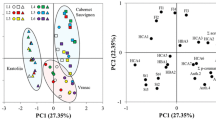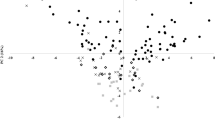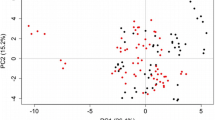Abstract
Four Greek monovarietal red wines, Agiorgitiko of Nemea, Xinomavro of Naousa, Mavrotragano of Santorini and Fociano of Ikaria, were characterized and classified in terms of volatile and phenolic composition. Total phenolic content (TPC) and color parameters were also studied. Forty-four volatile compounds were identified and semi-quantified by head space-solid phase microextraction-gas chromatography/mass spectrometry (HS-SPME–GC/MS) and five phenolic compounds were analyzed using high-performance liquid chromatography (HPLC–DAD). Concerning the total volatile fraction, Xinomavro showed the highest amount as it was particularly rich in alcohols, esters and hydrocarbons, while in the other three wine varieties ranged at lower concentrations. Furthermore, Xinomavro and Mavrotragano recorded the highest phenolic content, whereas Fociano recorded the lowest concentrations in both TPC and individual phenolic components. As far as classification results are concerned, the application of statistical analysis (multivariate analysis of variance/linear discriminant analysis—MANOVA/LDA), on volatile compounds resulted in a rather high classification rate (87.5%). Finally, the respective rates for color and TPC phenolics were also quite satisfactory (75% and 62.5%, respectively).




Similar content being viewed by others
Abbreviations
- TPC:
-
Total phenolic content
- HS-SPME–GC/MS:
-
Head space-solid phase microextraction-gas chromatography/mass spectrometry
- HPLC:
-
High-performance liquid chromatography
- MANOVA:
-
Multivariate analysis of variance
- LDA:
-
Linear discriminant analysis
- PDO:
-
Protected designation of origin
- GAE:
-
Gallic acid equivalents
- RI:
-
Retention Index
- ANOVA:
-
Analysis of variance
- TDN:
-
1,2-Dihydronaphthalene-1,1,6-trimethyl
References
European Commission, European Union (EU) Agricultural Product. Quality Policy, Specific EU Quality Schemes-Guaranteeing Quality (2003) https://ec.europa.eu/agriculture/quality. Accessed 10 Dec 2018
European Commission, European Union (EU), eAmbrosia—the EU geographical indications register (2019) https://ec.europa.eu/info/food-farming-fisheries/food-safety-and-quality/certification/quality-labels/geographical-indications-register/. Accessed 6 Oct 2019
Rebolo S, Peña RM, Latorre MJ, García S, Botana AM, Herrero C (2000) Characterisation of Galician (NW Spain) Ribeira Sacra wines using pattern recognition analysis. Anal Chim Acta 417:211–220
Díaz C, Conde JE, Méndez JJ, Pérez Trujillo JP (2002) Chemometric studies of bottled wines with denomination of origin from the Canary Islands (Spain). Eur Food Res Technol 215:83–90
Falqué E, Fernández E, Dubourdieu D (2002) Volatile components of Loureira, Dona Branca, and Treixadura wines. J Agric Food Chem 50:538–543
Ziółkowska A, Wąsowicz E, Jeleń HH (2016) Differentiation of wines according to grape variety and geographical origin based on volatiles profiling using SPME-MS and SPME–GC/MS methods. Food Chem 213:714–720
Sen I, Tokatli F (2014) Authenticity of wines made with economically important grape varieties grown in Anatolia by their phenolic profiles. Food Control 46:446–454
Sen I, Tokatli F (2016) Differentiation of wines with the use of combined data of UV-visible spectra and color characteristics. J Food Compos Anal 45:101–107
Urbano M, Luque de Castro MD, Pérez PM, García-Olmo J, Gómez-Nieto MA (2006) Ultraviolet–visible spectroscopy and pattern recognition methods for differentiation and classification of wines. Food Chem 97:166–175
Acevedo FJ, Jiménez J, Maldonado S, Domínguez E, Narváez A (2007) Classification of wines produced in specific regions by UV-visible spectroscopy combined with support vector machines. J Agric Food Chem 55:6842–6849
Meléndez ME, Sánchez MS, ĺñiguez M, Sarabia LA, Ortiz MC (2001) Psychophysical parameters of colour and the chemometric characterisation of wines of the certified denomination of origin ‘Rioja’. Anal Chim Acta 446:159–169
Kosma I, Badeka A, Vatavali K, Kontakos S, Kontominas M (2016) Differentiation of Greek extra virgin olive oils according to cultivar based on volatile compound analysis and fatty acid composition. Eur J Lipid Sci Technol 118:849–861
Kosma I, Vatavali K, Kontakos S, Kontominas M, Kiritsakis A, Badeka A (2017) Geographical differentiation of greek extra virgin olive oil from late-harvested Koroneiki cultivar fruits. J Am Oil Chem Soc 94:1373–1384
Papapetros S, Louppis A, Kosma I, Kontakos S, Badeka A, Kontominas MG (2018) Characterization and differentiation of botanical and geographical origin of selected popular sweet cherry cultivars grown in Greece. J Food Compos Anal 72:48–56
Ibern-Gómez M, Andrés-Lacueva C, Lamuela-Raventós RM, Waterhouse AL (2002) Rapid HPLC analysis of phenolic compounds in red wines. Am J Enol Vitic 53:218–221
Field A (2009) Discovering statistics using SPSS. Sage Publications Ltd, London
Basalekou M, Strataridaki A, Pappas C, Tarantilis PA, Kotseridis Y, Kallithraka S (2016) Authenticity determination of Greek-Cretan mono-varietal white and red wines based on their phenolic content using attenuated total reflectance fourier transform infrared spectroscopy and chemometrics. Curr Res Nutr Food Sci J 4:54–62
Boulton RB, Singleton VL, Bisson LF, Kunkee RE (1996) Principles and practice of winemaking. Chapman and Hall, New York
Clarke RJ, Bakker J (2004) Wine flavour chemistry. Blackwell Publishing Ltd, Oxford
Ayestarán B, Martínez-Lapuente L, Guadalupe Z, Canals C, Adell E, Vilanova M (2019) Effect of the winemaking process on the volatile composition and aromatic profile of Tempranillo Blanco wines. Food Chem 276:187–194
Francis IL, Newton L (2000) Determining wine aroma from compositional data. Aust J Grape Wine Res 11:114–126
Sánchez Palomo E, Díaz-Maroto MC, González-Viñas MA, Soriano-Pérez A, Pérez-Coello MS (2007) Aroma profile of wines from Albillo and Muscat grape varieties at different stages of ripening. Food Control 18:398–403
Fenoll J, Manso A, Hellín P, Ruiz L, Flores P (2009) Changes in the aromatic composition of the Vitis vinifera grape Muscat Hamburg during ripening. Food Chem 114:420–428
Oliveira MJ, Faria M, Sá F, Barros F, Araújo MI (2006) C6-alcohols as varietal markers for assessment of wine origin. Anal Chim Acta 563:300–309
Berger RG (2007) Flavours and fragrances. Chemistry, bioprocessing and sustainability. Springer, Berlin
Geckil H, Barak Z, Chipman MD, Erenler OS, Webster AD, Stark CB (2004) Enhanced production of acetoin and butanediol in recombinant Enterobacter aerogenes carrying Vitreoscilla hemoglobin gen. Bioprocess Biosyst Eng 26:325–330
Revi M, Badeka A, Kontakos S, Kontominas MG (2014) Effect of packaging material on enological parameters and volatile compounds of dry white wine. Food Chem 152:331–339
Tsakiris A (1998) Oenology: from grape to wine. Pcychalou, Athens (in Greek)
Griesbaum K, Behr A, Biedenkapp D, Voges HW, Garbe D, Paetz C, Collin G, Mayer D, Höke H (2002) In: Ullmann’s Encyclopedia of Industrial Chemistry. Wiley-VCH Verlag GmbH & Co, Weinheim
Jackson RS (2002) Wine tasting. A professionαl handbook. Elsevier Academic Press, San Diego
Ribereau-Gayon Ρ, GΙοries Υ, Maujean Α, Dubourdieu D (2006) Handbook οf oenology. The chemistry οf wine stabilization and treatments, vol 2. Wiley, Chichester
Jackson RS (2009) Wine tasting: a professional handbook. Academic Press, London
Zalacain A, Marín J, Alonso GL, Salinas MR (2007) Analysis of wine primary aroma compounds by stir bar sorptive extraction. Talanta 71:1610–1615
González-Barreiro C, Rial-Otero R, Cancho-Grande B, Simal- Gándara J (2015) Wine aroma compounds in grapes: a critical review. Crit Rev Food Sci Nutr 55:202–218
Sales JM, Resureccion AVA (2014) Resveratrol in peanuts. Crit Rev Food Sci Technol 54:734–770
Flamini R, Mattivi F, De Rosso M, Arapitsas P, Bavaresco L (2013) Advanced knowledge of three important classes of grape phenolics: anthocyanins, stilbenes and flavonols. Int J Mol Sci 14:19651–19669
Lorrain B, Ky I, Pechamat L, Teissedre PL (2006) Evolution of analysis of polyphenols from grapes, wines, and extracts. Molecules 18:1076–1100
Palade LM, Popa ME (2018) Polyphenol fingerprinting approaches in wine traceability and authenticity: assessment and implications of red wines. Beverages 4:1–18
Higdon J, Drake VJ, Steward WP (2016) Resveratrol. Micronutrient Information Center. Linus Pauling Institute, Oregon State University, Corvallis
Kalithraka S, Arvanitoyannis IS, Kefalas P, El-Zajouli A, Soufleros E, Psarra E (2001) Instrumental and sensory analysis of Greek wines; implementation of principal component analysis (PCA) for classification according to geographical origin. Food Chem 73:501–514
Ivanova-Petropulos V, Hermosín-Gutiérrez I, Boros B, Stefova M, Stafilov T, Vojnoski B, Dörnyei A, Kilár F (2015) Phenolic compounds and antioxidant activity of Macedonian red wines. J Food Compos Anal 41:1–14
Dourtoglou V, Antonopoulos A, Dourtoglou T, Lalas S (2014) Discrimination of varietal wines according to their volatiles. Food Chem 159:181–187
Stockham K, Sheard A, Paimin R, Buddhadasa S, Duong S, Orbell JD, Murdoch T (2013) Comparative studies on the antioxidant properties and polyphenolic content of wine from different growing regions and vintages, a pilot study to investigate chemical markers for climate change. Food Chem 104:500–506
Jaitz L, Siegl K, Eder R, Rak G, Abranko L, Koellensperger G, Hann S (2010) LC–MS/MS analysis of phenols for classification of red wine according to geographic origin, grape variety and vintage. Food Chem 122:366–372
Author information
Authors and Affiliations
Contributions
Conceptualization: AB; methodology: AB, DK, IK; software: DK, IK; formal analysis and investigation: DK, IK; data interpretation: AB, DK, IK; writing—original draft preparation: IK, DK; writing—review and editing: AB; funding acquisition: AB; resources: AB; supervision: AB.
Corresponding author
Ethics declarations
Conflict of interest
The authors declare no conflict of interest.
Compliance with ethics requirements
This article does not contain any studies with human and animal subjects.
Additional information
Publisher's Note
Springer Nature remains neutral with regard to jurisdictional claims in published maps and institutional affiliations.
Rights and permissions
About this article
Cite this article
Karimali, D., Kosma, I. & Badeka, A. Varietal classification of red wine samples from four native Greek grape varieties based on volatile compound analysis, color parameters and phenolic composition. Eur Food Res Technol 246, 41–53 (2020). https://doi.org/10.1007/s00217-019-03398-7
Received:
Revised:
Accepted:
Published:
Issue Date:
DOI: https://doi.org/10.1007/s00217-019-03398-7




